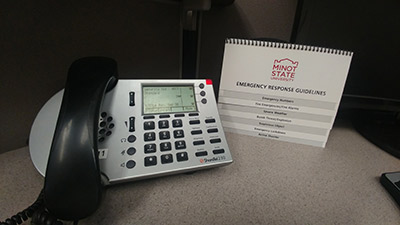Emergency Operations Guidelines

Communication in an Emergency:
Safety instructions for students, faculty and staff will be made available to the campus community through e-mail, text messaging, phone, the Minot State University Web site, and local media. The Assurance System will be used by MSU to contact faculty, staff and students in the case of an emergency. All media inquires should be directed to University Communications.
Emergency Phone List:
Police……………………...911
Security Direct Line…....701-500-2423
Facilities…………………..701-858-3210
Fire:
- If a flame or smoke is present, pull a fire alarm to activate the fire alarm system and call 911.
- Utilize a fire extinguisher to control the fire if appropriate.
- Shut off gas to any appliances in the area.
- Make sure everyone in the work area is aware of the emergency and is preparing to evacuate. Close doors behind you to confine the fire.
- Assist persons with disabilities.
- Use the nearest stairway - do not use an elevator.
- Return to the building only when authorized by emergency personnel.
Severe Weather:
Tornado –
- Stay inside, and move away from windows, doors, outside walls, mirrors, glass, and unsecured objects.
- Move to a lower level or a designated Severe Weather Safety Zone. Do not use elevators.
- Assist those with disabilities
- Continue to monitor weather via radio and/or other media.
Blizzard –
- Monitor weather forecasts in order to plan for a forecasted blizzard event.
- Remain in a safe place throughout the duration of a blizzard.
Bomb Threat:
- Listen carefully, be polite, and show interest.
- Keep caller talking, gather as much information as possible, and notate any background noises.
- Try to keep the caller talking to gain better information about the device
- Note the phone number, if displayed on caller I.D
- Utilize the yellow Bomb Threat card (available at any campus phone or from Campus Security) to gather useful information about the caller and situation for law enforcement.
- Contact the police immediately after the bomb threat call.
- Provide all relevant information to law enforcement.
- Do not evacuate unless told by law enforcement to do so.
Suspicious Object:
A suspicious object is any package, parcel, container, or other object that is suspected of being an explosive device because it is out of place or unusual for that location and cannot be accounted for, or because a threat has been received.
If you find a suspicious object:
- Do not touch the object.
- Move people away from the object.
- Do not use a portable radio or cell phone.
- Immediately notify the police using a landline (911).
- Follow police instructions precisely.
- Do not attempt to evacuate the building without the authorization or assistance of emergency personnel.
Characteristics of a Suspicious Letter or package:
- Restricted markings such as “personal” or “special delivery”.
- No return address or one that cannot be verified as legitimate.
- A city or state in the postmark that does not match the return address.
- Unusual weight based on size.
- Lopsided or oddly shaped, strange odors, oily stains, crystallization, protruding wires, rigid or bulky, excessive tape or string.
Emergency Lockdown:
- Follow instructions given by the Assurance messaging system.
- Proceed to an inner room, lock doors if possible. Barricade the door.
- If not in an interior room, shut off all lights.
- Place all electronic devices on silent.
- If near a computer, have Outlook email open to receive messages sent via Assurance.
- DO NOT leave the room until lockdown is completed or emergency personnel or Campus Security advises you to do so. Leaving a secure room during an emergency lockdown is done at your own risk.
- If the situation becomes critical and you must evacuate, Know where you are going, how you are going to get there, and move quickly.
Example of the Assurance message during lockdown:
“Effective immediately, MSU is initiating an emergency lockdown of all campus buildings. This is not a drill. Please proceed to a secure room immediately, shut off all lights, place cell phones on vibrate, and stay as far away from windows as possible. Updated information will be sent by electronic message as soon as possible.”
Active Shooter:
If an active shooter or other violence-related incident occurs on campus, all efforts will be made to protect lives and property until resources arrive to more effectively manage the event. Contact 911 and if possible Campus Security in the event of an active shooter, DO NOT put yourself at risk, contact emergency personnel after you are safe.
- Be aware of your environment and any possible dangers.
- Know your exits.
- If an exit is not an option, stay in the room, lock and/or barricade doors.
- Be prepared to confront the shooter if absolutely necessary.
Characteristics of an Active Shooter Situation:
- Victims are generally selected at random.
- The event is unpredictable and evolves quickly.
- Law enforcement is usually required to end an active shooter situation.
How to respond when an Active Shooter is in your vicinity:
Get Out
- Have an escape plan and route in mind.
- Leave your belongings behind.
- Keep your hands visible.
Hide out
- Hide in an area out of the shooter’s view.
- Block entry to your hiding place and lock the doors if possible.
- Silence your cell phone
Take Out
- If the shooter is in your immediate vicinity, you may need to distract or disable the assailant by throwing an object or striking with force.
Medical Emergencies:
Call 911 immediately to initiate an emergency response.
Administer First Aid if you are certified, and make sure you follow correct procedures.
Gather the victim’s history using the acronym SAMPLE:
S – Signs and Symptoms (Signs are visual, Symptoms are felt by the victim)
A – Allergies (Food, Medication, Environmental, etc.)
M – Medications (what is prescribed, whether they took their last dose, and when)
P – Previous Problems (had this issue before, when, and what was done)
L – Last Food or Drink
E – Events (events leading up to and causing the current issue, check for coherence which will help determine state of mind, shock, and possible brain trauma)
Is the person complaining of weakness, numbness or paralysis or lacks control of his/her limbs, bladder, or bowels?
If yes, do the following:
Assume the person has a spinal injury
Do not move; stabilize the patient to prevent paralysis or other serious conditions
The goal of first aid for a spinal injury is to keep the person in much the same position as he/she was found
Provide as much first aid as possible without moving the person's head or neck. If the person shows no signs of circulation (breathing, coughing or movement), begin CPR, but do not tilt the head back to open the airway. Use your fingers to gently grasp the jaw and lift it forward.
Question witnesses and be ready to give all information to the paramedics when they arrive.
Stay with the victim until help arrives.
Suicide/Suspicious Death
Suicide rarely occurs without warning to someone. Staff and students must take all comments about suicidal thoughts seriously, especially if details are provided.
When an individual is threatening suicide on campus and has a lethal weapon or drugs available:
- Remain calm and immediately contact 911 and/or Campus Security.
- Provide as much information as possible to 911/Campus Security (location, your name, name of suicidal individual, call-back phone number, and intended weapon/drug).
Sexual Assault
If a sexual assault occurs on campus, all efforts will be made to protect those affected, and the campus community. If there is a continuing threat to the campus, the Assurance NM, Social Media, website, and possibly the external blue light speakers will be activated to notify the campus community of the ongoing threat.
Contact Campus Security and report all known information. Campus Security will then do a brief interview of the victim, give initial information to the Title IX Coordinator, and assist Title IX and/or emergency responders as needed.
Campus Map
Printable Map [pdf]



